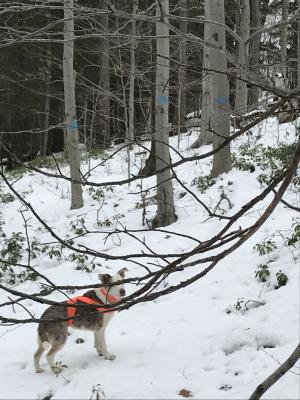A series of experimental timber harvest areas designed to create habitat for cottontails
- Tags:
- Timber Harvesting,
- Wildlife

Timber harvest prescriptions designed to expand mountain laurel understory to benefit rabbits at Heald Forest Reservation in Wilton
The Heald Tract Reservation in Wilton will have a timber harvest operation in the winter of 2018-19 that includes prescriptions to remove overstory trees to regenerate understory shrubs - specifically mountain laurel - that can greatly enhance cover for wildlife. The specific goal for improving the potential for New England cottontail rabbit habitat entails removing trees in blocks that collectively total 40 acres of a larger conventional timber harvest on approximaely 200 acres of adjacent forest. The entire property encompasses a total of 1492 acres.
This work is being is being completed through a unique partnership with the US Fish and Wildlife Service (USFWS), the Wildlife Management Institute, and UNH Cooperative Extension with funding provided by a grant from USFWS and Forest Society funding.
"Basal area" is a measure of tree density represented as square feet of trees per acre. The plan is to reduce tree density from 150 square feet of basal area down to 80 square feet and 30 square feet respectively to allow more light to reach and reinvigorate a shrubby thicket of mountain laurel in the understory. It may be easier to think about tree density in terms of the overhead canopy density. Less dense canopy will allow more light to reach the understory shrub layer.
The habitat improvements can also benefit a host of early successional (young forest) wildlife species. Right now the property does not support a viable population of New England or eastern cottontail rabbits. Old fields and adjacent, abandoned apple orchards do support other young forest species including snowshoe hare and ruffed grouse.

Trees marked with orange forestry paint indicate trees to be left behind in the lower tree density 30 square feet basal area blocks. Trees marked with blue forestry paint indicate trees to be cut in the higher tree density 80 square feet basal area blocks. Control blocks will remain unchanged. Following the timber harvesting, wildlife biologists can assess the understory condition.
New England cottontails are dependent upon dense shrub regeneration in the forest understory for food and cover. Due to agricultural land use history and a lack of understory shrubs in dense shade of closed canopy forests, the rabbits do not currently live at the Heald Forest. In other regions, New England cottontails are reliant on mutiflora rose thickets up to a meter in height which regenerated in former pastures. Both New England cottontail rabbits and eastern cottontail rabbits are generally not found in the understory of mature forests.
This project could benefit New England cottontail rabbits in other locations in subsequent years where wildlife biologists document their relative abundance via fecal pellet counts. Each year, hundreds of people volunteer as citizen scientists to help support rabbit research and New England cottontail conservation in New Hampshire through pellet surveys, spring plantings, and rabbit sightings.
According to the Forest Society's managing forester, Wendy Weisiger, "We are NOT working to create habitat for eastern cottontails. They are habitat generalists that live in less dense shrub habitats. We ARE trying to create the the kind of shrubby thicket habitat preferred by New England cottontails. Our ultimate goal isn't necessarily to introduce rabbits, but to see if this silvicultural prescription for a forest that has a presense of understory mountain laurel can work to increase that density over time. If the results show that it works, then wildlife habitat mangers can make similar recommendations for areas that have the same kind of conditions and also have nearby populations of New England cottontails."

In some regions of New Hampshire, eastern cottontails supplanted the native New England cottontails. The eastern cottontail is not native east of the Hudson River and was introduced to New England in the early 1900s as a game species. It is difficult to distinguish the species on physical appearances but there are subtleties that biologists recognize. The relative size of the eyes is different. Eastern cottontails have a depth perception of up to 30 feet and can react to threats or predators at a greater distance. New England cottontails have a smaller depth perception of approximately 15 feet and they require more dense, shrubby habitats for concealment cover.
The timber harvest at the Heald Tract will include a public tour of both the conventional timber harvest and the experimental blocks of tree density reduction to favor wildlife adapted to young forests and the presence of thick cover in the understory. The public tour will take place on Saturday, February 9, 2019 from 10 a.m. to 2 p.m.
